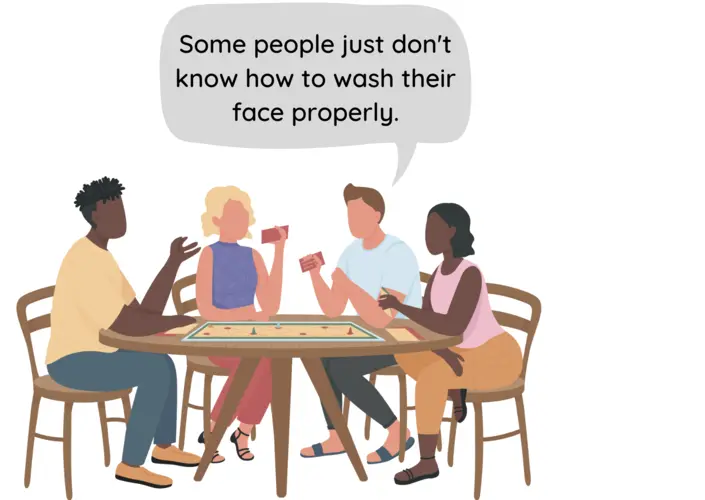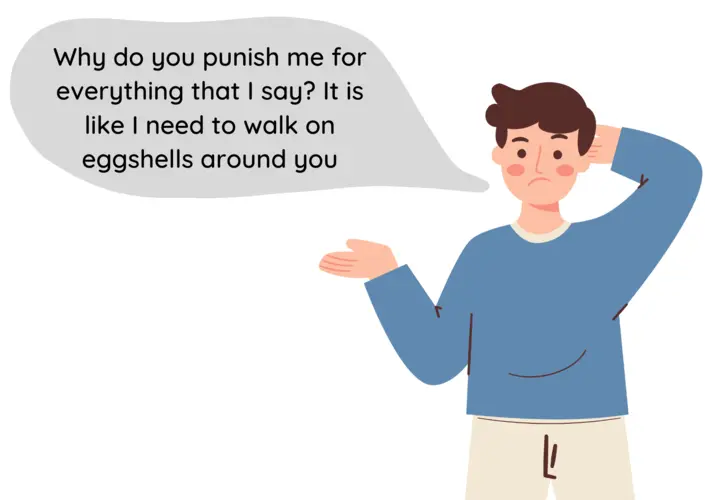According to a survey we conducted among 500 survivors of narcissistic abuse, the average duration of the love bombing phase with narcissistic men is five-and-a-half months and with narcissistic women it is three-and-a-half months.
When the love bombing phase ends, narcissists will begin the devaluation phase, which is often characterized as abusive, manipulative, devaluing, invalidating, degrading, confusing, dehumanizing, and inconsistent. Experiencing this phase can destroy your self-esteem, sense of self, and core values.
This article is going to guide you through some of the most common forms of abuse and manipulation that you’ll likely face during the devaluation phase so that you can grasp a comprehensive understanding of what comes after the love bombing phase.
Recommended Video:
How Love Bombing Affects Your Perception of Healthy Relationships by Dr. Daksha Hirani
For the best experience, please rotate your mobile device sideways.
10 Manipulation Tactics That You Will Experience After the Love Bombing Phase
The 10 most common manipulation tactics that you’ll likely face after the love bombing phase with a narcissist are the following:
- Gaslighting
- Narcissistic Rage
- Triangulation
- Intermittent Reinforcement
- Baiting
- Hoovering
- Flying Monkeys
- Projection
- Stonewalling
- Financial Abuse
Gaslighting
Gaslighting is a manipulation tactic that occurs when someone says or does something that doubts or denies another person’s reality.
For example, imagine that you are confronting the narcissist in your life because they said something mean to you.
You say, “I understand that you’re angry but that doesn’t give you a right to call me a (blank). It is a really mean thing to do.”

They respond with, “What on earth are you on about? I never said anything mean to you. Stop trying to portray me in a negative light.”
This is gaslighting.
Narcissists use gaslighting to get you to question your own sanity, memories, and/or perception of reality.
Narcissistic Rage
Narcissistic rage is an explosive, unpredictable, and unjustifiable response that narcissists have when they experience a narcissistic injury.
A narcissistic injury is a contradiction to a narcissist’s falsified identity. Take a narcissist’s grandiose sense of self-importance for example.
This is an unrealistic sense of specialness and superiority that causes an individual to truly believe that they are unique and better than others.
If you were to somehow contradict their grandiose sense of self-importance (i.e. “You think that you’re so special but you aren’t. There is nothing even remotely special about you.”) they would experience a narcissistic injury.

When a narcissist experiences a narcissistic injury, the painful thoughts, feelings, and emotions that they have get triggered.
Unfortunately, narcissists have low emotional intelligence so they’re incapable of managing these thoughts, feelings, and emotions on their own.
What they do instead is use projection to place their thoughts, feelings, and emotions onto others.
We will speak more about this later on in this article but projection is a defense mechanism that occurs when someone takes a part of their identity that they find unacceptable and places it onto someone else.
For example, a cheating wife accusing her husband of cheating instead of taking responsibility for her own actions.

Now, one of the ways that narcissists project their painful thoughts, feelings, and emotions onto others is through narcissistic rage.
When they experience a narcissistic injury, they want to make someone else feel as badly as they do so that they can figuratively point their finger at them and think to themselves, “I’m not the one who is weak, inadequate, and worthless, they are.”
This is projection.
Recommended Articles:
Our article “What Happens During Narcissistic Rage? (Survey With 100 Survivors)“ has a lot of helpful information that you can use to grasp a better understanding of narcissistic rage.
Our article “How Are Narcissists Made?“ has a lot of helpful information that you can use to learn about the painful thoughts, feelings, and emotions that narcissists have.
Triangulation
Triangulation is a manipulation tactic that occurs when someone turns a one-on-one situation into a two-on-one situation by involving a third party.
Narcissists use triangulation to create power imbalances in the interactions that they have with the people that they abuse.
For example, imagine that you have an argument with the narcissist in your life.
Later that day, you and the narcissist go out to dinner with a group of friends.
At dinner, the narcissist starts talking about the argument that the two of you had with your friend, even though the argument has nothing to do with them.
They say, “Can you please tell (your name) how insane he/she is being about this!“

This is triangulation.
The narcissist is involving a third party to create a two-on-one situation.
Triangulation is a very common manipulation tactic that narcissists use.
In fact, narcissists go out of their way to ensure that they are able to triangulate you.
How?
By isolating you from your friends and family and filling your surrounding environment with flying monkeys and narcissist enablers.
This makes it much easier for them to triangulate you and subject you to other forms of abuse and manipulation without being caught.
Intermittent Reinforcement
Intermittent reinforcement is the delivery of a reward at irregular intervals.
Narcissists use intermittent reinforcement to keep the people that they abuse hooked on them.
How?
Well, during the love bombing phase, narcissists typically use a manipulation tactic called mirroring to gather information about you.
In this context, mirroring is when a narcissist absorbs a ton of information about your identity and uses that information to create a falsified identity that you can identify with.

Over time, this manipulation tactic makes you feel heard, understood, and supported.
It can also make you feel like the narcissist is the perfect person for you.
This is true for all types of narcissistic relationships, not just romantic ones.
Once the love bombing phase ends and the devaluation phase begins, narcissists use intermittent reinforcement to prevent you from realizing that you are being abused.
The “reward” of intermittent reinforcement encourages you to stay in the relationship because you think that the narcissist is finally changing.
In fact, experiencing intermittent reinforcement after the love bombing phase can actually manipulate you into developing an addiction to the narcissist.
Recommended Article:
Our article “Why Do Trauma Bonds Feel Like an Addiction?“ has a lot of helpful information that you can use to understand how intermittent reinforcement creates addictions.
Baiting
Baiting is a manipulation tactic that occurs when someone says or does something manipulative to get another person to engage in a negative interaction with them.
For example, imagine that the narcissist in your life knew that you were very insecure about your acne.
While out with friends, they start making passive-aggressive comments about it (image below).

This would be considered narcissistic baiting.
Generally speaking, narcissists bait you into engaging in a negative interaction with them because they want to use your response to portray you in a negative light and/or victimize themselves.
For example, imagine that you got really angry and shouted at the narcissist for making a passive-aggressive comment about your acne.
They could use your response to portray you in a negative light and/or victimize themselves by saying something like, “Why do you punish me for everything that I say? It is like I need to walk on eggshells around you.”

Now, if you are with your real friends, they will be able to see that the narcissist is being passive-aggressive and support you.
But if you are surrounded by flying monkeys and narcissist enablers, they will support the narcissist and shame you for being “verbally abusive.”
Recommended Article:
Our article “Narcissistic Baiting (A Complete Guide 2023)“ has all the information that you need to know about narcissistic baiting.
Hoovering
Hoovering is a manipulation tactic that occurs when a narcissist says or does exactly what you need to hear or see to give them another chance.
For example, imagine that you’ve recently ended a relationship with a narcissist.
It was really hard, but you did it!
One day, the narcissist sends you a message that says, “I miss you so much… I can’t believe that I treated you so badly… I can’t imagine my life without you in it… Can we please fix this? I promise that I’ll go to therapy and do everything that I can to change.”

This is hoovering.
Now, as the example suggested, hoovering is a manipulation tactic that narcissists use at the end of the relationship.
When a narcissist successfully hoovers you, they will typically treat you well for a short amount of time to lure you into a false sense of security.
Then they will resume the devaluation phase once they sense that you’ve let your guard down.
Recommended Articles:
Our article “How to Deal With a Narcissist Who Is Hoovering“ has a lot of helpful information that you can use to better manage hoovering narcissists.
Our article “The Difference Between the Love Bombing and Honeymoon Phase” will help you understand the tactics narcissists use to lure you back into a false sense of security after hoovering.
Flying Monkeys
A flying monkey is someone a narcissist manipulates into helping them abuse others.
Narcissists use flying monkeys to isolate, control, and silence the people that they abuse.
Now, there are three types of flying monkeys that you need to watch out for.
1. Manipulated Flying Monkeys
A Manipulated Flying Monkey is created when a narcissist spreads demeaning lies about the person that they are abusing.
These lies are designed to support the narcissist’s narrative that portrays the person that they are abusing as the abuser and themselves as the victim.
A Manipulated Flying Monkey becomes a flying monkey because they believe the narcissist’s narrative.
2. Forced Flying Monkeys
A Forced Flying Monkey is created by the fear that narcissistic abuse creates in group settings (e.g. workplace, family, friend group).
A Forced Flying Monkey becomes a flying monkey because they are scared of becoming the target of the narcissist’s abuse if they don’t.
3. Natural Flying Monkeys
A Natural Flying Monkey is someone who becomes a flying monkey because they enjoy drama, toxic environments, and/or being abusive towards others.
They don’t necessarily believe in the narcissist’s narrative and they aren’t scared of them either.
A Natural Flying Monkey becomes a flying monkey because they like the drama, toxicity, and abuse it creates.
Recommended Article:
Our article “How to Deal With Flying Monkeys: Survey Among 450 Survivors” is filled with great strategies that you can use to protect yourself from flying monkeys.
Projection
Projection is a defense mechanism that occurs when someone takes a part of their identity that they find unacceptable and places them onto someone else.
In romantic narcissistic relationships, the most common manifestations of projection are cheating accusations.
Meaning that the narcissist will cheat on their partner and then accuse their partner of cheating instead of taking responsibility for their own unfaithful behavior.

In narcissistic family and work settings, the most common manifestation of projection is scapegoating.
A scapegoat is a person who is blamed for the wrongdoings, mistakes, or faults of others.
Narcissists always have a scapegoat that they use as a repository for their painful thoughts, feelings, and emotions.
A simple example of this could be a narcissistic father using his son as a scapegoat because he views his son as weak and undesirable.
Now, his son isn’t weak or undesirable.
What is happening here is the narcissistic father feels weak and undesirable but can’t manage these thoughts, feelings, and emotions on his own.
Instead, he projects them onto his son so he can figuratively point his finger at him and think to himself, “He is the one who is weak and undesirable, not me.”
Recommended Articles:
Our article “How Do You Know When a Narcissist Is Projecting?“ will help you spot narcissistic projection.
Our article “Why Do Narcissists Accuse You of Cheating?” has a lot of helpful information about cheating accusations and projection.
Our article “How Do Narcissists Choose Their Scapegoat?“ has a lot of important information about the role projection plays in scapegoating.
Stonewalling
Stonewalling is a manipulation tactic that occurs when someone refuses to participate in the communication or connection of a relationship that they have.
For example, imagine that you are trying to have a conversation with the narcissist in your life because they sold your belongings without asking you first.
Every time you go to speak the narcissist cuts you off and makes wild accusations that have nothing to do with the topic at hand (image below).

This would be considered stonewalling.
12 Signs of Stonewalling:
- They ghost you.
- They abruptly walk away from you.
- They pretend to be busy.
- They minimize your thoughts, feelings, emotions, and needs.
- They have aggressive body language (e.g. eye rolling or folding their arms).
- They use obsessive behaviors to avoid having a conversation about the problem that the two of you have (e.g. cleaning, organizing, hoarding, etc.).
- They are ignoring you or pretending that they don’t hear you.
- They are giving you one-word or one-lined answers.
- They change the subject to avoid speaking about a topic.
- They refuse to answer your questions.
- They make wild accusations rather than talk about the current problem.
- They engage in passive aggressive behaviors such as stalling or procrastination to avoid a problem.
Financial Abuse
As a general rule, there are three types of financial abuse that narcissists use.
The first type is economic exploitation.
Economic exploitation occurs when a narcissist intentionally destroys the financial resources and/or credit of the person that they are abusing.

The second type is employment sabotage.
Employment sabotage is when a narcissist uses abuse and/or manipulation to get the person that they are abusing to quit their job or to prevent them from finding a job.
5 Signs of Employment Sabotage

The third type is called controlling the finances.
Controlling the finances is when a narcissist uses abuse and/or manipulation to control the financial stability of the person that they are abusing.

Recommended Article:
Our article “34 Signs of Financial Abuse That You Need to Know!“ has helpful information about the signs of financial abuse that you should watch out for.
About the Author

Hey, I’m Elijah.
I experienced narcissistic abuse for three years.
I create these articles to help you understand and validate your experiences.
Thank you for reading, and remember, healing is possible even when it feels impossible.
References
Willock, B. (1987). The devalued (unlovable, repugnant) self: A second facet of narcissistic vulnerability in the aggressive, conduct-disordered child. Psychoanalytic Psychology, 4(3), 219–240
Kotyanaya, M. “Bridging the evidence-based gap: From pathological narcissism to narcissism survivors.” The Science of Psychotherapy (2020).
